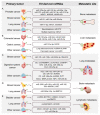Non-Coding RNAs of Extracellular Vesicles: Key Players in Organ-Specific Metastasis and Clinical Implications
- PMID: 36428785
- PMCID: PMC9688215
- DOI: 10.3390/cancers14225693
Non-Coding RNAs of Extracellular Vesicles: Key Players in Organ-Specific Metastasis and Clinical Implications
Abstract
Extracellular vesicles (EVs) are heterogeneous membrane-encapsulated vesicles released by most cells. They act as multifunctional regulators of intercellular communication by delivering bioactive molecules, including non-coding RNAs (ncRNAs). Metastasis is a major cause of cancer-related death. Most cancer cells disseminate and colonize a specific target organ via EVs, a process known as "organ-specific metastasis". Mounting evidence has shown that EVs are enriched with ncRNAs, and various EV-ncRNAs derived from tumor cells influence organ-specific metastasis via different mechanisms. Due to the tissue-specific expression of EV-ncRNAs, they could be used as potential biomarkers and therapeutic targets for the treatment of tumor metastasis in various types of cancer. In this review, we have discussed the underlying mechanisms of EV-delivered ncRNAs in the most common organ-specific metastases of liver, bone, lung, brain, and lymph nodes. Moreover, we summarize the potential clinical applications of EV-ncRNAs in organ-specific metastasis to fill the gap between benches and bedsides.
Keywords: anti-cancer metastasis; cancer biomarkers; extracellular vesicles; noncoding RNAs; organ-specific metastasis.
Conflict of interest statement
The authors declare no conflict of interest.
Figures


Similar articles
-
The role of tumor-derived extracellular vesicles containing noncoding RNAs in mediating immune cell function and its implications from bench to bedside.Pharmacol Res. 2023 May;191:106756. doi: 10.1016/j.phrs.2023.106756. Epub 2023 Apr 3. Pharmacol Res. 2023. PMID: 37019192 Review.
-
Noncoding RNAs of Extracellular Vesicles in Tumor Angiogenesis: From Biological Functions to Clinical Significance.Cells. 2022 Mar 10;11(6):947. doi: 10.3390/cells11060947. Cells. 2022. PMID: 35326397 Free PMC article. Review.
-
Extracellular Non-Coding RNAs in Cardiovascular Diseases.Pharmaceutics. 2023 Jan 3;15(1):155. doi: 10.3390/pharmaceutics15010155. Pharmaceutics. 2023. PMID: 36678784 Free PMC article. Review.
-
Extracellular Vesicle-Related Non-Coding RNAs in Hepatocellular Carcinoma: An Overview.Cancers (Basel). 2024 Apr 4;16(7):1415. doi: 10.3390/cancers16071415. Cancers (Basel). 2024. PMID: 38611093 Free PMC article. Review.
-
Comprehensive landscape of extracellular vesicle-derived RNAs in cancer initiation, progression, metastasis and cancer immunology.Mol Cancer. 2020 Jun 5;19(1):102. doi: 10.1186/s12943-020-01199-1. Mol Cancer. 2020. PMID: 32503543 Free PMC article. Review.
Cited by
-
Mechanisms of tumor-associated macrophages affecting the progression of hepatocellular carcinoma.Front Pharmacol. 2023 Aug 17;14:1217400. doi: 10.3389/fphar.2023.1217400. eCollection 2023. Front Pharmacol. 2023. PMID: 37663266 Free PMC article. Review.
-
Exploring the potential of the convergence between extracellular vesicles and CAR technology as a novel immunotherapy approach.J Extracell Biol. 2024 Sep 26;3(9):e70011. doi: 10.1002/jex2.70011. eCollection 2024 Sep. J Extracell Biol. 2024. PMID: 39328262 Free PMC article. Review.
-
Emerging roles of non-coding RNA derived from extracellular vesicles in regulating PD-1/PD-L1 pathway: insights into cancer immunotherapy and clinical applications.Cancer Cell Int. 2025 May 23;25(1):188. doi: 10.1186/s12935-025-03809-8. Cancer Cell Int. 2025. PMID: 40410719 Free PMC article. Review.
-
Role of Triple-Negative Breast Cancer-Derived Extracellular Vesicles in Metastasis: Implications for Therapeutics and Biomarker Development.J Cell Mol Med. 2025 Mar;29(5):e70448. doi: 10.1111/jcmm.70448. J Cell Mol Med. 2025. PMID: 40032646 Free PMC article. Review.
-
Exosomal microRNAs in cancer: Potential biomarkers and immunotherapeutic targets for immune checkpoint molecules.Front Genet. 2023 Feb 17;14:1052731. doi: 10.3389/fgene.2023.1052731. eCollection 2023. Front Genet. 2023. PMID: 36873941 Free PMC article. Review.
References
Publication types
Grants and funding
LinkOut - more resources
Full Text Sources
Miscellaneous

